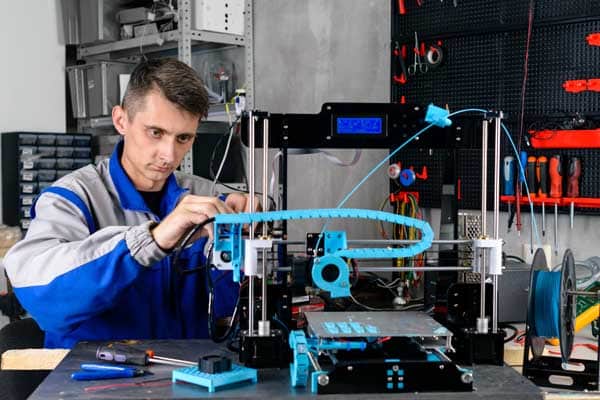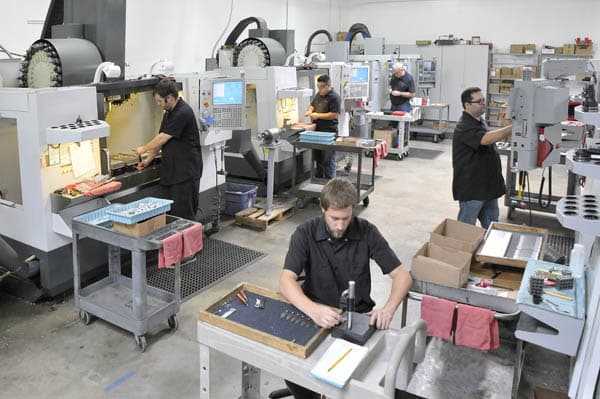Hiring manufacturing workers is a challenge. The high demand for manufacturing workers and the current low unemployment rate are making it difficult for manufacturers to find qualified candidates. In addition, many manufacturing jobs require specific skills that can be difficult to find in the general workforce. As a result, manufacturers are often compelled to either pay higher wages to attract qualified candidates or train unskilled workers on the job. Both of these options can increase the cost of production and make it difficult for manufacturers to compete in the global marketplace.
Finding skilled workers to fill the hiring gaps in manufacturing is becoming more complex year after year, often due to misconceptions and challenges in connecting with new talent. There is a common misconception that all manufacturing jobs are low-skilled when in reality, many manufacturing jobs require advanced skills and training. In addition, manufacturing jobs are often located in rural areas, making it difficult for urban job seekers to connect with open positions.

As a result, manufacturers must work harder to connect with qualified candidates and dispel common misconceptions about manufacturing jobs. Only by addressing these challenges will manufacturers be able to find the skilled workers they need to keep their businesses running.
According to a study by Deloitte LLP and The Manufacturing Institute, “89% of manufacturing executives agree that there’s a talent shortage in the industry.” The study noted that this skills gap could create up to 2.4 million unfilled positions between 2019 and 2028.
We know that hiring manufacturing workers isn’t the easiest task, so we’ve put together this short guide with six tips to help improve your hiring process and obtain the best candidates for your company.
- Reach out to Potential Candidates.
Potential employees need to know about your job openings if they’re going to apply, so start by looking at how you are marketing available positions. Is your career page mobile friendly? Are you highlighting success stories or employees who were promoted from within?
Easy access to job information and the potential for advancement will attract quality candidates to apply for your positions. To expand your applicant pool even further, consider partnering with local community colleges or technical schools that promote careers in manufacturing. You could also host an open house to introduce potential candidates to what the factory looks like and what types of jobs are available. In-person meetings can draw in applicants you might not have contact with if you rely on online-only recruitment.
- Alter Perceptions
There are a lot of misconceptions about manufacturing jobs – that they are repetitive, poorly paid, and require physically demanding tasks. These false assumptions get in the way of companies connecting with quality talent and addressing these misconceptions can help immensely in the hiring process.
Ensure that candidates understand that the job opportunities can be varied, offer growth potential, and don’t necessarily require physically demanding or repetitive tasks. There are opportunities in everything from technology to engineering, as well as positions that focus on operating machinery or using fine motor skills. Make it known that growth potential abounds, and salaries are competitive.
- Employees Speak the Loudest
Happy employees are the best recruiters you can find. Getting current employees to speak about your excellent work environment, impressive benefits, or close-knit team can do wonders to get recruits on board. Offer incentives to get your team to write reviews on employer review sites and focus on developing your employee referral program. One of the best ways to find interested, partially-vetted candidates is via referrals from current (happy) employees.
- Intelligent Interviews
Flipping through resumes won’t likely get you the best blue-collar workers, as manufacturing candidates might have trouble articulating their accomplishments on paper. Intelligent interviews can help. Asking behavioral interview questions can help to determine where skill sets genuinely lie and if a potential candidate would fit in nicely with your company culture.
Behavioral interview questions explore how a potential candidate might deal with a challenge based on previous experiences. You might ask questions such as “What would you do if you saw a co-worker violating safety protocol?” or “What is the most difficult piece of equipment you ever had to troubleshoot? How did you solve the problem?”
These types of questions can help you determine if future employees will work through difficult situations or rise to challenges and if they’re likely to be good team members. Asking intelligent questions can give insight into a person’s values and whether they will fit well in your company.
- Choose Trainable Talent
You must change your approach to finding quality employees during a talent shortage. Instead of hiring for experience, choose people for their core characteristics. A strong work ethic, the ability to work well with others, and a thirst for learning is a foundation that’s more than solid enough to work with. It’s often easier to train someone with these qualities to do a technical job than to find someone with specialized knowledge who fits your company culture.
Invest in your own employee training program, and you’ll be able to expand your talent pool exponentially.
- Ask for Help
If you’re having trouble hiring full-time employees or just looking to add temporary employees for short or long-term work, consider reaching out to a company specialized in connecting manufacturing companies to their ideal employees. RSS Inc. provides temporary staffing for manufacturing warehousing and production companies, and its talent pool is expansive and well-vetted.
3 Tips to Keep Your Employees
You’ve hired some great employees. Now how do you retain them? The manufacturing sector is vital to the economy but faces many challenges. One of the most significant challenges is the need to be more efficient and leaner to compete in a global market. This challenge is especially pronounced in the manufacturing sector, where companies must often find ways to reduce costs and increase productivity.
The manufacturing industry is also facing the challenge of an aging workforce. Many workers in the manufacturing sector are nearing retirement age, and there are not enough young workers to replace them. As a result, companies are facing a shortage of skilled labor. Despite these challenges, the manufacturing sector remains an integral part of the economy. It provides jobs for millions of workers and contributes to producing essential goods and services.
Here are three tips that can help you keep your manufacturing workers on board:
1) Offer incentives and recognition
In any work environment, it is important to find ways to motivate employees. After all, a motivated workforce is often a productive one. Incentives and recognition can be powerful motivators for workers. Offering bonuses or other rewards for meeting production goals can help encourage employees to do their best. Similarly, public recognition for a job well done can also be an effective way to boost morale and motivation. Of course, every employee is different, and what works as a motivator for one person may not work for another. As such, it is important to take the time to get to know your employees and find out what makes them tick. By understanding what drives your workers, you can more effectively motivate them to meet your company’s goals.
2) Create a positive work environment
Manufacturing workers often spend long hours on their feet in loud, hectic environments. As an employer, it’s essential to create a positive work environment that is safe and comfortable. Some simple ways to improve the work environment for manufacturing employees include providing comfortable flooring and ensuring that there is enough space for workers to move around freely. Also, good lighting and ventilation are important, as is reducing noise exposure by using earplugs or noise-canceling headphones. By taking these steps, you can create a work environment that is more pleasant for employees and helps to reduce turnover.
3) Promote professional development opportunities
A recent study found that employees who feel they are constantly learning and growing are more likely to be engaged in their work. The study also found that employees who felt their job was providing them with new challenges were more engaged than those who felt their job was routine. These findings suggest that employers need to provide training and development opportunities to keep their workers engaged. While this may seem like an obvious solution, the reality is that many employers fail to invest in employee development. A survey of 500 companies found that only 19% of companies provide formal training opportunities for employees. This means that there are a lot of companies out there missing out on the benefits of an engaged workforce. If you want to keep your employees engaged, make sure you are providing them with opportunities to learn and grow.
While there are many other ways to make sure you retain good employees, the tips we’ve outlined here are a great starting point. By following these tips, you can ensure that your manufacturing workforce is both happy and productive.
Learn more about our staffing services:









